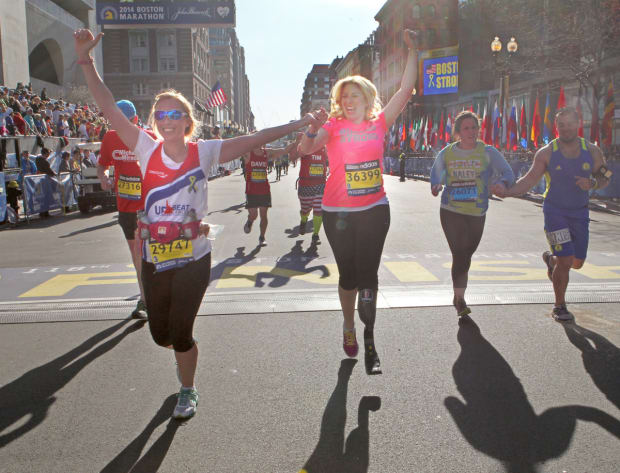Heather Abbott never misses the Boston Marathon. Not before 2013 and not since.
She hosts an annual watch party on Boylston Street, right near the finish line, filled with friends and supporters. The location is ideal—a spot to witness all the joy and catharsis of months of work ending in accomplishment—and so is the company. The group always includes some of her fellow amputees, people she has met through mutual friends or through her foundation, for which the party is a fundraiser.
“We’re all part of that one community,” says David Hiler, one of the group. “We’re like a true band, a true team, when we go down there together and watch and cheer people on.”
They will all be there Monday, for the 127th Boston Marathon, a watch party a decade in the making at the spot where Abbott’s life changed forever.

Jessica Pohl
Abbott, who works in human resources and lives in Newport, R.I., had long had a tradition of going to watch the marathon with friends. But everything changed in 2013, after Tamerlan and Dzhokhar Tsarnaev planted two bombs near the finish line, killing three and injuring more than 250, Abbott included. The blast sent her through the door of a restaurant, smoke and blood and broken glass everywhere. (Among the people who helped carry Abbott to safety were former Patriots lineman Matt Chatham and his wife, Erin, who still come to her marathon watch party each year.) She underwent three surgeries in four days.
One was still to come: Her left leg would soon be amputated below the knee.
It was difficult to process, not only because of what she was losing, but also because of all the new challenges she was gaining. Abbott soon came to understand that different contexts required different prostheses—running, swimming, wearing high heels. If the last one sounds trivial, it was especially important to Abbott, who had always loved fashion and had an impressive shoe collection. Her heels were a symbol of her life as it used to be. Now, she was faced with the idea that “I’ll never be able to just pick out a pair of shoes that I want to wear and then wear them,” she remembers. She had tried to prepare herself for the difficulties of relearning to walk, to run, to do activities like paddleboarding. But she hadn’t considered it would be difficult to do something as simple as wear her shoes. Which meant that of all the prosthetic options she received after her amputation, the cosmetic leg that allowed her to wear heels felt especially, personally critical.
“It was, I think, a big part of my healing process and my own mental sanity, being able to not have to give that up,” Abbott says.
Other than a basic, everyday prosthesis, none were covered by insurance. For Abbott, that was not a problem: The marathon bombings had attracted so much attention and inspired so much support that she was able to receive multiple prosthetics at no personal cost. (She now has five, including waterproof and high-impact activity options, as well as her cosmetic leg for heels.) But it didn’t take long for her to realize how unusual that was. In the months after the bombings, Abbott became a certified peer visitor through the Amputee Coalition, a group that helps people through the process of losing a limb. In visiting new and soon-to-be amputees, she found she had plenty to share about the emotional and physical journey. But there was little she could do for them when it came to navigating the insurance bureaucracy. A basic prosthesis allows an amputee to walk. But there is no running, no beach trips, no climbing or snowboarding or other cherished hobbies unless you can afford additional specialized prostheses that cost tens of thousands of dollars out of pocket. Every amputee had their own personalized version of high heels—something they loved, that made them feel like themselves, that linked them to their life before amputation. But not every amputee had prosthetic options that would let them access it.
So in late 2014, barely a year and a half after the bombings, she established the Heather Abbott Foundation. The organization donates prostheses that allow amputees to do more than simply walk.
“It felt almost like an obligation, I guess, to figure out a way to give back to a community that was so helpful to me—to figure out a way to help other amputees get the devices they needed to move on with their lives,” Abbott says.
Abbott’s foundation has now given prostheses to about 100 people. The beneficiaries have ranged in age from 5 to 63; they have lost limbs through illnesses, accidents and surgery complications. Their prostheses have allowed them to dance, swim, run, play high school sports and, yes, wear high heels. In recent years, the work has been made easier by a Danish startup called Levitate, which offers low-cost running blades. That’s allowed the foundation to afford dozens of additional prostheses and help a greater volume of people more quickly than it otherwise could. And every year, some of them gather at the marathon, reuniting and cheering on the runners.

Nancy Lane/MediaNews Group/Boston Herald/Getty Images
The group includes David Hiler. The 58-year-old ran the Boston Marathon twice, in 2015 and ’16, as part of a generally active life. But when the Vermont man was diagnosed a few years later with cartilage bone cancer that threatened his left leg, he wasn’t sure how much of that life he would have to give up. His annual New Year’s Day hike with his wife. His love of snowboarding. His trips to the beach. His surgeon promised him he would have a chance to do all of that and more after an amputation. But he wasn’t sure what it would look like. Before his surgery in January ’20, his family organized a “Farewell to Leg” tour, giving him one more chance to hike and run and snowboard before he entered a world in which all of that would be different.
The first part of the process was relearning how to walk. (“It’s an interesting thing, when you’re in your 50s, to decide that you have to learn to walk,” Hiler says. “I mean, you did it once, and now 50 years later, you’re doing it again.”) And the next one was learning just how difficult it would be to accomplish everything that followed—not just physically or mentally, but financially, given how expensive the prostheses could be and how little there was in the way of insurance options.
“You learn really quickly,” Hiler says. “Through insurance, you get one leg. They’ll allow you to walk again. … Beyond that, everything else is considered a frivolous activity.”
He began researching charitable organizations that could help with access to different prostheses. Each one felt like a lifeline.
“It’s everything,” Hiler says. “The first time that I got on a snowboard and started going down the mountain—it wasn’t about snowboarding as an amputee. I was just snowboarding. And running is so different and difficult, but I still get that feeling, you know? When I get into the groove, I still get it, I get that rhythm. It’s just like it always was.”
The donated prostheses mean that he can enjoy not just the activities he’s always loved, but new ones, too—like surfing. With the waterproof prosthetic he got from the Heather Abbott Foundation, he tried catching waves for the first time last summer.
“I was terrible,” he says with a laugh. “I was awful.”
Will he go again this summer?
“Oh, yeah,” says Hiler, who already has plans with the same amputee surfing group in New Jersey. “I can’t wait.”

Dina Rudick/The Boston Globe/Getty Images
Hiler has long had a love of marathons: He ran four before his amputation and would like to one day complete another. “Every one of them is a personal triumph, every single time you do it, no matter how fast you run,” he says.
To stand by the finish line each year with Abbott’s group is to watch that triumph up close, thousands of times over, and to share it with a set of people who share a singular understanding of one another.
“It’s an overwhelming emotional experience, because you know what a triumph it is to achieve that,” Hiler says. “So I don’t sit there and go, Boy, I wish I was out there. But I just feel this great sense of pride for those people. I’m just so impressed by the human resilience to be able to go do that.”
This milestone, 10 years on, doesn’t necessarily feel different from any other marathon year, Abbott says. There’s extra attention, extra media coverage, extra incentive to reflect. But she has never spent much time dwelling on what was taken from her. Instead, she thinks of what others gave, and the ripple effect of what she has been able to give back.
“If you’d told me before that I’d be running a nonprofit, aside from my regular job, I don’t think I would have believed it,” Abbott says. “But it does feel almost like an obligation. I mean, I was given so much help and was really so fortunate to have so much support. How could I not provide that support to other people?”







